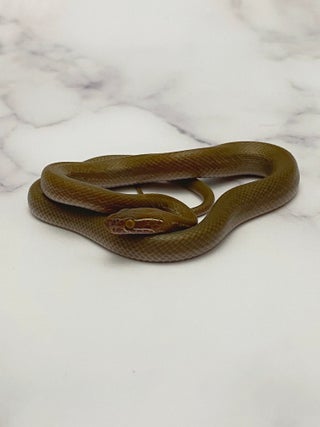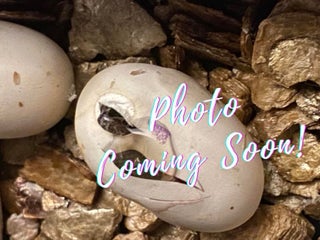Albino T- Cape House Snake
|
T- albinos are typically yellow orange in color with red pupils. Perhaps it would be more appropriate to label both strains of "albino" amelanistic, but this is what they are commonly referred to as, so this is how I present them to you.
|
|
Albino T+ Cape House Snake
|
The best way to tell a T+ albino apart from a T - albino is by the eye color. T+ albinos have black pupils and T- albinos have red pupils.
It is important to note that t- and t+ albino strains are not compatibile, meaning they can not be bred together to create visual offspring. Breeding a T+ and a T- albino would create normal 100% double het T- & T+ albinos. An animal that is visually both strains of albino has red pupils. |
|

Granite Kzn Red T+ Albino, PDH T- & Hypo Female (KZNALFB-32523)
Sold out
Granite is a pattern that is polygenetic, similar to how pattern in crested gecko genetics work.
Kzn Red is a locality that produces red color as they age,
Siblings of this girl have red pupils so its possible she is het t- albino too. Father has sired hypo babies so she's 50% het hypo.
Put all that together and you have. granite, kzn red, visual t+ albino, and possibly carrying both t- and hypo.
Albino T- & Hypo
|
It is very difficult to tell a T- Albino Hypo apart from a T- albino that just happens to be very light colored. Both parents of the animal pictured (Moonglow) were visual hypos so she must also be hypo. Her parents also have lineage for T+ albino so its possible she may be both T+ and T- albino and hypo. We will see when she reproduces.
She was born kind of light pink with teal eyes, and retained those traits as she aged. She has a bit of a green sheen to her white sections from the hypo. A very interesting snake which will be ready to breed soon. |
|
Albino T+ & Hypo - a.k.a. Sunglow or Hybino
|
Also known as a Sunglow or a Hybino. Tell them apart from a light colored t+ by their eye color which is typically a shade of green, and the whiter appearance.
|
|
Aurora House Snakes- Lamprophis Aurora
|
An insanely beautiful snake but not as forgiving of husbandry errors or set up mistakes, and as such I do not recommend them for inexperienced keepers. At the time of writing, to my knowledge they have never been successfully hybridized. There are some wild Albinos and some line bred traits of them however.
|
|
Black House Snakes
|
Black house snakes are gorgeously shiny and when captive born are very well mannered. Adults typically eat frozen thawed voraciously although the hatchlings are best kept by those with access to live prey as they wont always eat frozen thawed for every meal. These are my own line of blacks that are line bred to be darker. Most blacks do have white belly scales either as hatchlings or as they age.
Another interesting fact is they change color from a deep rich black all the way to light kalamata olive green- and any shade between. They can do this to any part of their body, in any pattern, at any time. |
|
Black House Snake Olivaceus Project
|
Several years ago, I saw a picture of Boaedon Olivaceus and became obsessed. However, much to my disappointment, I've never once found one available. So I set out to... kind of... create one. Using black house snakes, over the years, I have selectively bred to recreate the look of boaedon olivaceus. These animals are the fruit of that labor. While they will never be that species, and it is certainly a work in progress still, I am amazed at the gene plasticity that house snakes have to allow me to make the progress I have made towards that aim.
|
|
Available Offpsring
Black T- Albino Cape Hybrid
|
The product of crossing a black house snake with a T- Albino Cape, then breeding those offspring to each other. I'm fascinated by their head structure and black eye rings. I already have a T+ albino version in the works as well.
|
|
Black Hypo Cape Hybrid
|
A project in the works. The product of crossing a black house snake with a Hypo Cape, then breeding those offspring to each other. Pictured are hets.
|
|
Black & Uganda Green Hybrid
|
Another hybrid pairing in attempt to understand the messy genetics and taxonomy of house snakes. These beautiful snakes are the product of crossing a black and Uganda Green together. As of April 2021, I've created just one pair so far "Diesel" and "Oil Slick"
|
|
Other Potential Black Projects
|
An importer I know had informed me of a pair of wild caught snakes they got in with a bunch of other snakes that they believe to be morph black house snakes. Unfortunately they were not willing to part with the pair but hopefully they will be willing to part with some of their offspring. So I look forward to acquiring some in the future and seeing if it proves out.
|
|
Blue Eye House Snake
|
Born in shades of silver, the blue eye house snake turns white as it ages. Adults are often white with a tint of pink or peach and of course blue eyes.
|
|
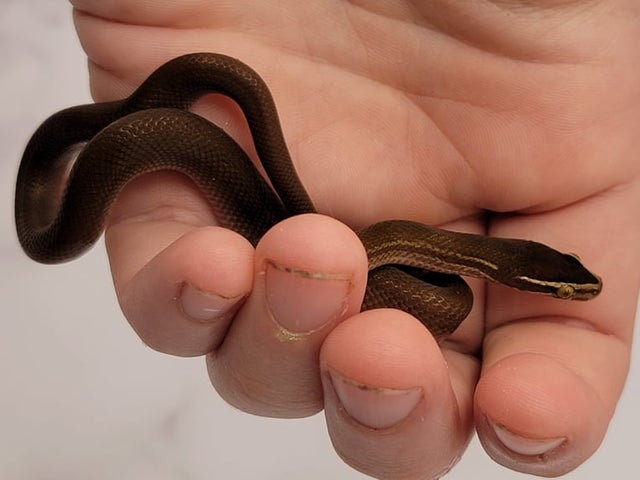
Part Green 100% Het Blue Eye, possible het Hypo Male 2
Haven't yet caught him changing color so cant really say what he shifts to. He's still young and a bit shy. Feeds consistently on frozen thawed/prekill.
Ok so here's the genetics breakdown for this guy:
Great grandparents were a hypo green and a blue eye made from an east london cape (hence the stripes),
So the grandparents were 25% green blood, double 100 het hypo & blue eye. They were bred to each other.
This hatchling's father is the greenest visible blue eye from that clutch. He is possibly hypo too but its hard to tell for sure and hasn't been proven out yet.
This hatchling's mother was the greenest female of that clutch. Their pairing produced a green blue eye, so mom is 100 het blue eye, but in a clutch of only 5, there were no hatchlings I could say with 100% certainty were hypo. If dad is hypo then the clutch is all 100% het hypo, if not then they still could be carrying the het from either side. So its hard to say whether not this hatchling is het hypo or not, but there is definitely a possibility of it. Hope it helps!

Blue Eye, Part Green, Possible Het Hypo Male
Sold out
Feeds consistently on frozen thawed pinky mice. Color shifts between light silver to green to deeper grey. Still a baby and one of the first of his kind so will be cool to see how he colors up as he ages.
Ok so here's the genetics breakdown for this guy: Basically I bred a hypo green to a blue eye, raised those up and bred them back to each other. Walah. To be more specific...
Great grandparents were a hypo green and a blue eye made from an east london cape (hence the stripes),
So the grandparents were 25% green blood, double 100 het hypo & blue eye. They were bred to each other.
This hatchling's father is the greenest visible blue eye from that clutch. He is possibly hypo too but its hard to tell for sure and hasn't been proven out yet.
This hatchling's mother was the greenest female of that clutch. Their pairing produced a "green" blue eye, so mom is 100 het blue eye, but in a clutch of only 5, there were no hatchlings I could say with 100% certainty were hypo. If dad is hypo then the clutch is all 100% het hypo, if not then they still could be carrying the het from either side. So its hard to say whether not this hatchling is also hypo or 66 het hypo, but there is definitely a possibility of it. Hope it helps!
Blue Eyed T- Albino House Snake
|
The color of a newborn t-albino blue reminds me a bit of banana morph ball pythons. They lose the color as they shed and are quite white as adults. I find it interesting that the blue iris is still visible with the red pupils.
|
|
Blue Eyed T+ Albino House Snake
|
Recently produced by Donovan Paul Carstens in South Africa. This is the only one i'm currently aware of. Can't wait to see how it develops!
I do have a t+ blue project in the works and am currently raising up some double hets. |
|
Blue Eyed Hypo House Snake
|
A typical blue eye hatchling is a silver color and lose color as they age. A hypo blue eye is born already fairly light. This is a fairly new gene (as of the time of writing in 2021), with only a few in existence as far as I know.
|
|
Butter T- Albino House Snake
|
The product of a cross between two t- Ilumos, (an ilumo is a zambian green house snake and an albino cape house snake). These insanely beautiful hybrids are either bright yellow or orange. It doesnt seem to matter which combination of the two I pair. I always seem to get both yellow and orange in every clutch. These don't seem to color shift as dramatically as others do, and the T- version does have red pupils like all t- albinos do.
|
|
Butter T+ Albino House Snake
|
The product of a cross between two t+ Ilumos, (an ilumo is a zambian green house snake and an albino cape house snake). The T+ butter has a softer more caramel appearance than the T- with the standard black pupils. Color is gorgeously warm, like what I imagine toasted butter would look like, if that was possible :)
|
|
Butter T+ Albino Hypo
|
Another hybrid animal in the butter family, the hypo t+ butter is made a couple ways but one way to do it is to cross a hybino to a green house snake then cross back, or you could use a hypo green and cross to a t+ albino and cross back. Anyway, its a green house snake, T+ albino, and hypo.
The hypo presence washes out the color nearly completely to a soft buttery beige. |
|
Butter T- Albino Hypo
Bug Eye House Snake - Boaedon Mentalis
|
These large eyed beauties can be a little tricky as babies and so are best suited to a more experienced keeper.
|
|
East London Locality Cape
|
A locality of cape house snake from the east london area that feature stripes.
|
|
Extreme Gene Albino
|
The first extreme genes are descendants of a wild caught exceptionally bright t- albino captured in the east london area. More information about the extreme gene can be found here.
|
|
Facemask
|
During the midst of the 2020 Covid 19 pandemic I hatched out an interesting cape house snake with a white face that resembles a facemask. A couple months later I hatched another one with the same features this time in albino form. Still not 100% sure if its genetic or not but it looks promising.
|
|
File Snake - Mehelya Crossi
|
Not a house snake but a fun lamprophiid all the same. Every scale is keeled giving them a texture similar to a file. They are easy to keep, calm, fun to watch, and turn a beautiful purple/pink color.
|
|
Available Offspring
Granite
|
Also called "speckled" more recently. I call this granite pattern because thats what it was sold to me as several years ago. I believe it got that name from its similarity to the granite spotted python or granite burmese python morphs.
This is one of the many patterns that naturally occur when breeding cape house snakes. Its not a "morph" per se but I have noticed as I have line bred for this pattern that the majority of the offspring from this line are hatching with the granite pattern. I think in time I will be able to get this pattern to bred true and only granites will hatch from granite parents. |
|
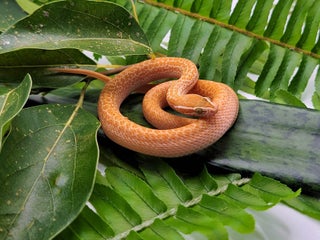
Granite Kzn Red T+ Albino, PDH T- & Hypo Female (KZNALFB-32523)
Sold out
Granite is a pattern that is polygenetic, similar to how pattern in crested gecko genetics work.
Kzn Red is a locality that produces red color as they age,
Siblings of this girl have red pupils so its possible she is het t- albino too. Father has sired hypo babies so she's 50% het hypo.
Put all that together and you have. granite, kzn red, visual t+ albino, and possibly carrying both t- and hypo.
Green House Snake Zambian Locality
|
|
Hypo Zambian Green House Snake
|
|
Hallowell's House Snake (Boaedon Virgatus)
|
|
Hypo Cape House Snake
|
|
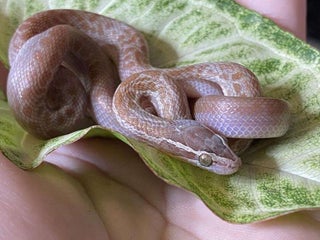
Hypo Female (hypojtf72823)
Sold out
Hypos always are gorgeous, and tend to look a little different depending on the light you catch them in, so I took a bunch of pictures so you can see her in different light.
This girl currently eats live newborn pinkies, but I suspect she'd eat frozen thawed too if offered small enough. I just havent tried myself yet.
I am still building this morph up myself so I haven't offered a hypo for sale in roughly 3 years. However, I do need some funds to go see my dad who was recently diagnosed with cancer, so a few very special offerings are available for a limited time. Long story short, this is your chance. Shes the only one im offering and she wont last long.
"Inverted" Albino
KZN Red
|
Kzn is the abbreviation for KwaZulu Natal a region in africa where wild red house snakes are collected from.
|
|
KZN Red T- Albino House Snake
|
Created by crossing a kzn red to an albino and crossing back. Unlike the Red Kenya these guys are born kind of brownish and gain their red as they age. In albino form they are hard to distinguish from a regular albino at first but eventually color up into a beautiful red color.
|
|
KZN Red T+ Albino House Snake
|
|
Marble
|
|
Mole Snake
|
|
Olive House Snake (Lycodonomorphus Inornatus)
|
|
Oreo
|
|
Patternless
|
A South African locality that produces gorgeous true patternless snakes.
|
|
Pied
|
|
Red Kenya
|
A locality of house snakes that are naturally red. Unlike the KZN red the red kenya are born red already but do seem to gain some color as they age too.
|
|
Red Kenya x Kzn Red Cross
|
A cross pairing to see if they would be compatible and to know what a hybrid of the two would look like in hopes of a visual clue to tell locality pure animals from non-locality pure animals.
|
|
Red Kenya T- Albino
|
|
Available Offspring
Red Kenya T- Albino Hypo
|
Turns out when you cross a red kenya albino to a hypo you don't get a pink snake, like how it works in many other morphs of house snake. You get a vibrant yellow one. Pulls the red right out. Kind of interesting.
|
|
Spotted House Snake
|
Lamprophis Guttatus, small, rare, and beautiful. I'm not producing these quite yet, but I am raising up breeders now and am looking forward to making these more accessible to American house snake keepers in the future.
|
|
Tanzanian Stripe House Snake - Boaedon Lineatus
|
Beautiful dwarf house snakes with big eyes. I breed two lines of these, both aiming for wide white stripes and one that has gold eyes and one that has considerably more red.
|
|
Togo Stripe
|
Commonly imported and parasitized, but make great pets when captive born or once those issues are dealt with. In fact, my favorite house snake in my collection is actually a rescued togo stripe. I have a few lines of these working towards double stripes and higher contrast. These can get just as big as capes too.
|
|










